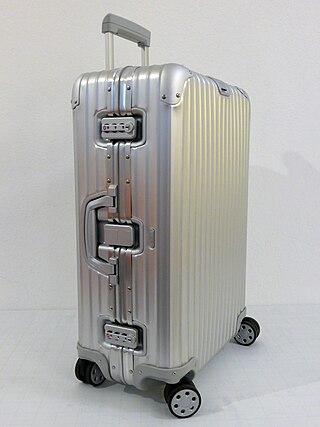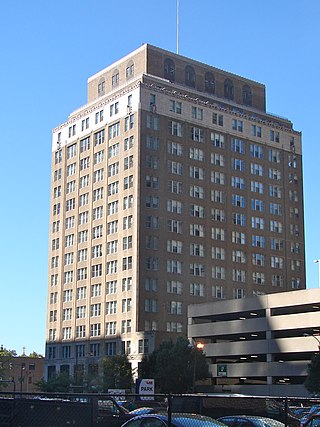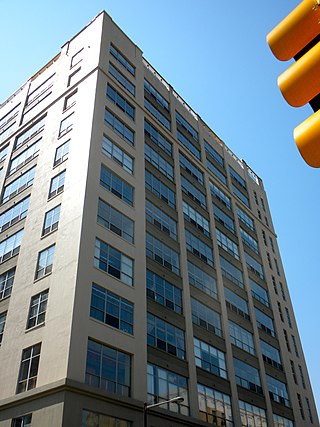
A suitcase is a form of luggage. It is a rectangular container with a handle and is typically used to carry one's clothes and other belongings while traveling. The first suitcases appeared in the late 19th century due to the increased popularity of mass tourism at the time and were meant to hold dress suits. They were originally made using heavier materials such as leather or steel, but, beginning in the 1930s, were constructed with more lightweight materials like plastic and cardboard.

Louis Vuitton Malletier, commonly known as Louis Vuitton, is a French luxury fashion house and company founded in 1854 by Louis Vuitton. The label's LV monogram appears on most of its products, ranging from luxury bags and leather goods to ready-to-wear, shoes, perfumes, watches, jewellery, accessories, sunglasses and books. Louis Vuitton is one of the world's leading international fashion houses. It sells its products through standalone boutiques, lease departments in high-end departmental stores, and through the e-commerce section of its website.

A trunk, also known as a travel trunk, is a large cuboid container designed to hold clothes and other personal belongings. They are most commonly used for extended periods away from home, such as for boarding school, or long trips abroad. Trunks are differentiated from chests by their more rugged construction due to their intended use as luggage, instead of the latter's pure storage.

Baggage or luggage consists of bags, cases, and containers which hold a traveler's personal articles while the traveler is in transit. A modern traveler can be expected to have packages containing clothing, toiletries, small possessions, trip necessities. On the return trip, travelers may have souvenirs and gifts. For some people, luggage and the style thereof is representative of the owner's wealth and status. Luggage is constructed to protect the items during travel either with a hard shell or a durable soft material. Luggage often has internal subdivisions or sections to aid in securing items. Handles are typically provided to facilitate carrying, and some luggage may have wheels and/or telescoping handles or leashes to make moving them easier.
Strawbridge's, formerly Strawbridge & Clothier, was a department store in the northeastern United States, with stores in Pennsylvania, New Jersey, and Delaware. The Center City Philadelphia flagship store was, in its day, a gracious urban emporium. The retailer started adding branch stores starting in the 1930s and, by their zenith in the 1980s, enjoyed annual sales of over a billion dollars By the 1990s, Strawbridge's became part of the May Department Stores conglomerate until May's acquisition by Federated Department Stores on August 30, 2005.

The trunk or boot of a car is the vehicle's main storage or cargo compartment, often a hatch at the rear of the vehicle. It can also be called a tailgate.
A malletier is, in French, literally a trunk-maker, or manufacturer of luggage and suitcases..

Founded in 1878 by Simon Seward, the Petersburg, Virginia-based Seward Trunk Co. was once the nation's largest manufacturer of steamers, trunks, footlockers, and other luggage. In 1967, Seward was purchased by the Dayco Corporation, the former Dayton Rubber Company, of Dayton, Ohio. The company is now a unit of Advantus, Corp. of Jacksonville, Florida which purchased the former owner, Mercury Luggage(also of Jacksonville) in 2016. Seward trunks are sold by fine retailers throughout the USA.
Martin Maier was the founder and proprietor of Martin Maier Trunk and Bag Company, which specialized in making specialty and sample trunks. His company, based in Detroit, Michigan, was one of the largest luggage and leather goods distributors in the Midwestern United States.

Martin Mathias Secor was a Bohemian American immigrant and businessman. He was the founder and proprietor of the Northwestern Trunk and Traveling Bag Manufactory and the M. M. Secor Trunk Company, and was the 28th and 31st mayor of Racine, Wisconsin.

Founded in 1920 by Louis Knell, the Youngstown, Ohio-based Armored Trunk Manufacturing Company was one of America's largest manufacturers of steamers, trunks and luggage. During the Dust Bowl, Armored relocated west to Los Angeles, California where the company developed a reputation for building quality products to protect belongings while in transit.
Moynat is a Parisian trunkmaker, founded in Paris in 1849 by Octavie and François Coulembier. They collaborated with a specialist in travel goods, named Pauline Moynat, to open the company's first store at Avenue de l'Opera. The house is notable for its innovations in making trunks lighter and waterproof, and for its participation in the various World's Fairs.

Tanner Krolle is a manufacturer of leather goods based in London.

The Bell Telephone Company Building is a historic 17 story skyscraper located at 1835 Arch Street in the Logan Square neighborhood on the edge of downtown Philadelphia, Pennsylvania which was used as a long distance telephone exchange by the Bell Telephone Company. Its construction in 1925 marked the beginning of the era of long distance trunk lines in telephone communication. The building was listed by the National Register of Historic Places in 2000.
H.J. Cave & Sons is a London-based fashion house specialising in luxury leather accessories. Founded in 1839 by Harriet Jane Cave. H.J. Cave is believed to be the first designer of the modern leather handbag.

The Larkin–Belber Building, also known as the Larkin Building and the Belber Trunk & Bag Company Building, is an historic, American light manufacturing loft building that is located in the Logan Square neighborhood of Philadelphia.

Au Départ is a Parisian trunkmaker founded in Paris in 1834.
Lancel is a French Maison of luxury leather goods, founded in Paris in 1876 by Angèle and Alphonse Lancel and developed by their son Albert.
Papworth Industries was the name given to the manufacturing arm of Papworth Village Settlement, a Cambridgeshire colony for sufferers of tuberculosis founded in 1916. The luggage and travel-goods division was bought by the London firm of Swaine Adeney Brigg in 1997.
The House of Finnigans was a British luxury luggage and trunk maker established in 1830, originally in Manchester and later in New Bond Street in London. The House of Finnigans manufactured and produced a wide range of luxury products, including trunks, bags, fashion, jewellery, timepieces, and silverware.













